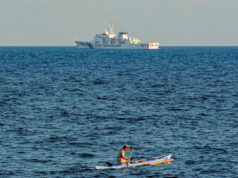SWS: 64% support closure of Boracay for one year

A MAJORITY of 64% of Filipino adults agreed, and 20% disagreed, with the government’s recommendation to close the entire island of Boracay to tourists for one year for full rehabilitation, according to a noncommissioned poll by the Social Weather Stations (SWS).
This gives a net agreement score (% agree minus % disagree, correctly rounded) of +44, classified by SWS as “very strong” in its First Quarter 2018 Social Weather Survey fielded on March 23-27. (SWS terminology for net agreement is as follows: +50 and above, “extremely strong”; +30 to +49, “very strong”; +10 to +29, “moderately strong”; +9 to -9, “neutral”; -10 to -29, “moderately weak”; -30 to -49, “very weak”; -50 and below, “very weak”; -50 and below, “extremely weak.”)
The survey also found 64% agreeing that the closure would help rehabilitate the tourist island it would help (37% “definitely help” plus 28% “somewhat help,” correctly rounded), while 16% answered that Boracay’s closure would not help its rehabilitation (8% “somewhat not help” plus 8% “definitely not help”). Twenty percent were undecided.
Further, the poll found 61% agreeing that the closure would help increase the number of tourists in the future (36% “definitely help” plus 25% “somewhat help”), while 16% answered it would not help (9% “somewhat not help” plus 7% “definitely not help”). On this matter, 23% were undecided.

Majorities across socio-demographics agreed with the government’s recommendation to close Boracay for one year for full rehabilitation, with stronger support coming from Mindanao, the urban areas, and those with higher educational attainment, the survey said.
Net agreement with the government’s recommendation to close Boracay was highest in Mindanao at an “extremely strong” +55 (68% agree, 13% disagree), followed by Metro Manila at a “very strong” +49 (69% agree, 20% disagree), Balance Luzon at a “very strong” +45 (64% agree, 20% disagree, correctly rounded), and the Visayas at a “moderately strong” +26 (53% agree, 27% disagree).
Net agreement was an “extremely strong” +50 (68% agree, 18% disagree) in overall urban areas, compared to the “very strong” +38 (59% agree, 21% disagree) in overall rural areas.
Support for the closure of Boracay was stronger among those with higher educational attainment — with net agreement highest among college graduates at an “extremely strong” +54 (70% agree, 16% disagree), followed by high school graduates at an “extremely strong” +50 (69% agree, 18% disagree), non-elementary school graduates at a “very strong” +34 (55% agree, 20% disagree), and elementary school graduates at a “very strong” +33 (57% agree, 23% disagree).
The proportion of those who said the closure of Boracay would help rehabilitate the nature in the island was highest in Metro Manila at 71%, followed by Balance Luzon and Mindanao, both at 64%, and the Visayas at 61%.
On the other hand, the proportion of those who said Boracay’s closure would help increase the number of tourists in the future was highest in Metro Manila at 68%, followed by Mindanao at 61%, Visayas at 60%, and Balance Luzon at 58%.
The survey was conducted using face-to-face interviews of 1,200 adults (18 years old and above) nationwide: 300 each in Metro Manila, Balance of Luzon, Visayas and Mindanao, with sampling error margins of ±3% for national percentages, and ±6% each for the said areas. — G.M. Cortez



